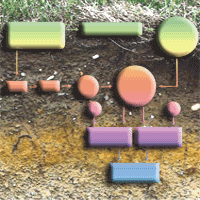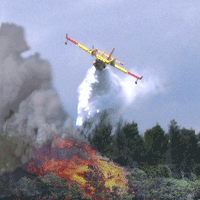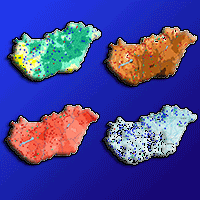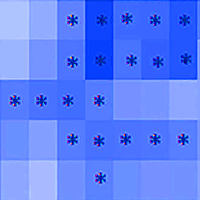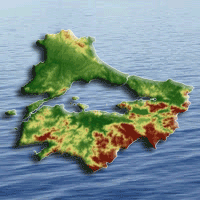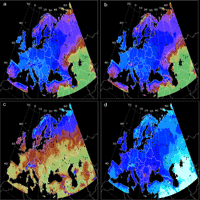A semi-empirical model has been used to estimate total net primary productivity, canopy transpiration and the water use efficiency under actual and future climate projections (B1 and A2 IPCC Scenarios) of two deciduous (Fagus sylvatica, Quercus cerris) and one evergreen tree species (Quercus ilex) growing in Italy. In response to changes in the air temperature, the two deciduous species showed a strong reduction of NPP values, whereas the evergreen one showed very limited reductions. Under future warmer conditions, Q. ilex proved to be the best adapted species, probably for its drought-tolerant water-saving strategy, while Q. cerris suffered a reduction of transpiration, due to stomatal closure which was sensitive to the change of evaporative demand. Water Use Efficiency (WUE) values did not increase in the B1 and A2 scenarios, indicating a non-conservative water-saving strategy, which likely affected the distribution pattern of Q. cerris under these conditions. Similar functional behaviour have been noted for F. sylvatica, although this species adopted a water spending strategy, typical of species growing in mesic environments, that could represent a risk for survival of beech population under extreme air temperature change. In this respect, the reduced suitable area for this species under the A2 scenario could reduce the possibilities of an upward shift toward higher altitudes.
Keywords
, , , ,
Citation
Vitale M, Mancini M, Matteucci G, Francesconi F, Valenti R, Attorre F (2012). Model-based assessment of ecological adaptations of three forest tree species growing in Italy and impact on carbon and water balance at national scale under current and future climate scenarios. iForest 5: 235-246. - doi: 10.3832/ifor0634-005
Academic Editor
Marco Borghetti
Paper history
Received: Aug 08, 2012
Accepted: Oct 10, 2012
First online: Oct 24, 2012
Publication Date: Oct 30, 2012
Publication Time: 0.47 months
© SISEF - The Italian Society of Silviculture and Forest Ecology 2012
Open Access
This article is distributed under the terms of the Creative Commons Attribution-Non Commercial 4.0 International (https://creativecommons.org/licenses/by-nc/4.0/), which permits unrestricted use, distribution, and reproduction in any medium, provided you give appropriate credit to the original author(s) and the source, provide a link to the Creative Commons license, and indicate if changes were made.

Breakdown by View Type
(Waiting for server response...)
Article Usage
Total Article Views: 60850
(from publication date up to now)
Breakdown by View Type
HTML Page Views: 50201
Abstract Page Views: 4297
PDF Downloads: 4853
Citation/Reference Downloads: 32
XML Downloads: 1467
Web Metrics
Days since publication: 4823
Overall contacts: 60850
Avg. contacts per week: 88.32
Article Citations
Article citations are based on data periodically collected from the Clarivate Web of Science web site
(last update: Mar 2025)
Total number of cites (since 2012): 23
Average cites per year: 1.64
Publication Metrics
by Dimensions ©
Articles citing this article
List of the papers citing this article based on CrossRef Cited-by.
(1)
Ainsworth EA, Long SP (2005)What have we learned from 15 years of free-air CO
2 enrichment (FACE)? A meta-analytic review of the responses of photosynthesis, canopy properties and plant production to rising CO
2. New Phytologist 165: 351-372.
CrossRef |
Gscholar
(2)
Allen RG, Pereira LS, Raes D, Smith M (1998)Crop evapotranspiration: guidelines for computing crop water requirements. Irrigation and Drainage Paper No. 56, UN-FAO, Rome.
Gscholar
(3)
Amthor JS, Goulden ML, Munger JW, Wofsy SC (1994)Testing a mechanistic model of forest-canopy mass and energy exchange using eddy correlation: carbon dioxide and ozone uptake by a mixed oak-maple stand. Australian Journal of Plant Physiology 21: 623-651.
CrossRef |
Gscholar
(4)
Attorre F, Alfò M, De Sanctis M, Francesconi F, Bruno F (2007)Comparison of interpolation methods for mapping climatic and bioclimatic variables at regional scale. International Journal of Climatology 27:1825-1843.
CrossRef |
Gscholar
(5)
Attorre F, Francesconi F, Scarnati L, De Sanctis M, Alfò M, Bruno F (2008)Predicting the effect of climate change on tree species abundance and distribution at a regional scale. iForest 1: 132-139.
CrossRef |
Gscholar
(6)
Attorre F, Francesconi F, Valenti R, Vitale M, Alfò M, Bruno F (2011)Evaluating the effects of climate change on tree species abundance and distribution in the Italian peninsula. Applied Vegetation Science 14:242-255.
CrossRef |
Gscholar
(7)
Ball JT, Woodrow IE, Berry JA (1987)A model predicting stomatal conductance and its contribution to the control of photosynthesis under different environmental conditions. In: “Progress in photosynthesis research”(Biggins I ed). Vol. IV, Martinus Nihjoff, Dordrecht, The Netherlands, pp. 221-224.
Gscholar
(8)
Betts RA, Boucher O, Collins M, Cox PM, Falloon PD, Gedney N, Hemming DL, Huntingford C, Jones CD, Sexton D, Webb MJ (2007)Projected increase in continental runoff due to plant responses to increasing carbon dioxide. Nature 448: 1037-1041.
CrossRef |
Gscholar
(9)
Bossel H (1996)TREEDYN3 forest simulation model. Ecological Modelling 90:187-227.
CrossRef |
Gscholar
(10)
Bunce JA (1992)Stomatal conductance, photosynthesis and respiration of temperate deciduous tree seedlings grown outdoors at an elevated concentration of carbon dioxide. Plant Cell and Environment 15: 541-549.
CrossRef |
Gscholar
(11)
Chirici G, Barbati A, Maselli F (2007)Modelling of Italian forest net primary productivity by the integration of remotely sensed and GIS data. Forest Ecology and Management 246: 285-295.
CrossRef |
Gscholar
(12)
Ciais P, Reichstein M, Viovy N, Granier A, Ogee J, Allard V, et al. (2005)Europe-wide reduction in primary productivity caused by the heat and drought in 2003. Nature 437:529-533.
CrossRef |
Gscholar
(13)
Cochard H, Bréda N, Granier A (1996)Whole tree hydraulic conductance and water loss regulation in Quercus during drought: evidence for stomatal control of embolism? Annals of Science Forest 53:197-206.
CrossRef |
Gscholar
(14)
Cochard H, Martin R, Gross P, Bogeat-Triboulot MB (2000)Temperature effects on hydraulic conductance and water relations of
Quercus robur L. Journal of Experimental Botany 51: 1255-1259.
CrossRef |
Gscholar
(15)
Curtis PS (1996)A meta-analysis of leaf gas exchange and nitrogen in trees grown under elevated CO
2 in situ. Plant Cell and Environment 19: 127-137.
CrossRef |
Gscholar
(16)
Dai Y, Zeng X, Dickinson RE, Baker I, Bonan GB, Bosilovich MG, Denning AS, et al. (2003)The Common Land Model (CLM). Bulletin of the American Meteorological Society 84:1013-1023.
CrossRef |
Gscholar
(17)
De Luis M, Garcia-Cano MP, Cortina J, Raventós J, González-Hidalgo JC, Sánchez JR (2001)Climatic trends, disturbances and short-term vegetation dynamics in a Mediterranean shrubland. Forest Ecology and Management 147: 25-37.
CrossRef |
Gscholar
(18)
de Wit CT, Goudriaan J, van Laar HH, Penning de Vries FWT, Rabbinge R, van Keulen H, Louwerse W, Sibma L, de Jonge C (1978)Simulation of assimilation, respiration and transpiration of crops. Simulation Monographs, PUDOC, Wageningen, The Netherlands.
Gscholar
(19)
Di Traglia M, Attorre F, Francesconi F, Valenti R, Vitale M (2011)Is cellular automata algorithm able to predict the future dynamical shifts of tree species in Italy under climate change scenarios? A methodological approach. Ecological Modelling 222 (4): 925-934.
CrossRef |
Gscholar
(20)
Dilley AC (1968)On the computer calculation of vapor pressure and specific humidity gradients from psychometric data. Journal of Applied Meteorology 7: 717-718.
CrossRef |
Gscholar
(21)
Faria T, Silvério D, Breia E, Cabral R, Abadía A, Abadía J, Pereira JS, Chaves MM (1998)Differences in the response of carbon assimilation to summer stress (water deficits, high light and temperature) in four Mediterranean tree species. Physiologia Plantarum 102: 419-428.
CrossRef |
Gscholar
(22)
Eamus D, Jarvis PG (1989)The direct effects of increase in the global atmospheric CO
2 concentration on natural and commercial temperate trees and forests. Advances in Ecological Research 19: 1-55.
CrossRef |
Gscholar
(23)
Filella I, Llusià J, Piñol J, Peñuelas J (1998)Leaf gas exchange and fluorescence of
Phillyrea latifolia, Pistacia lentiscus and
Quercus ilex saplings in severe drought and high temperature conditions. Environmental and Experimental Botany 39: 213-220.
CrossRef |
Gscholar
(24)
Fischer RA,Williams M, Lola da Costa A, Malhi RF, da Costa RF, Almeida S, Meir P (2007)The response of an Eastern Amazonian rain forest to drought stress: results and modelling analyses from a throughfall exclusion experiment. Global Change and Biology 13: 2361-2378.
CrossRef |
Gscholar
(25)
Fosberg MA (1990)Global change - a challenge to modeling. In: “Process modelling of forest growth responses to environmental stress” (Dixon RK, Mehldahl MS, Ruark GA, Warren WG eds). Timber Press, Portland, OR, USA.
Gscholar
(26)
Friend AD, Woodward FI (1990)Evolutionary and ecophysiological responses of mountain plants to the growing season environment. Advances in Ecological Research 20: 59-124.
CrossRef |
Gscholar
(27)
Goudriaan J, Shugart HH, Bugmann H, Cramer W, Bondeau A, Gardner RH, et al. (1999)Use of models in global change studies. In: “The terrestrial biosphere and global change” (Walker B, Steffen W, Canadell J, Ingram J eds). Cambridge University Press, Cambridge, UK.
Gscholar
(28)
Granier A, Ceschia E, Damesin C, Dufrêne E, Epron D, Gross P, Lebaube S, et al. (2000)The carbon balance of a young beech forest. Functional Ecology 14: 312-325.
CrossRef |
Gscholar
(29)
Granier A, Reichstein M, Breda N, Janssens IA, Falge E, Ciais P, et al. (2007)Evidence for soil water control on carbon and water dynamics in European forests during the extremely dry year: 2003. Agricultural and Forest Meteorology 143: 123-145.
CrossRef |
Gscholar
(30)
Harley PC, Thomas RB, Reynolds JF, Strain BR (1992)Modelling photosynthesis of cotton grown in elevated CO
2. Plant, Cell and Environment 15: 271-282.
CrossRef |
Gscholar
(31)
Herrick JD, Maherali H, Thomas RB (2004)Reduced stomatal conductance in sweetgum (
Liquidambar styraciflua) sustained over long-term CO
2 enrichment. The New Phytologist 162: 387-396.
CrossRef |
Gscholar
(32)
Husch B, Beers TW, Kershaw JA (2003)Forest Mensuration. Wiley, New York, USA, pp. 465.
Gscholar
(33)
IPCC (2007)Fourth Assessment Report (Walser ML, Nodvin SC eds). Intergovernmental panel on climate change, Fourth Assessment Report 2007.
Online |
Gscholar
(34)
IPCC-SRES (2007)Climate change 2007: the physical science basis. Contribution of working group I to the fourth assessment report of the intergovernmental panel on climate change (Solomon S, Qin D, Manning M, Chen Z, Marquis M, Averyt KB, Tignor M, Miller HL eds). Cambridge University Press, Cambridge, UK and New York, USA, pp. 996.
Gscholar
(35)
Jarvis PG, Edwards WRN, Talbot H (1981)Models of plant and crop water use. In: “Mathematical and Plant Physiology” (Rose DA, Charles-Edwards CW eds). Academic Press, London, UK, pp. 151-194.
Gscholar
(36)
Keenan T, Sabate S, Gracia C (2010)Soil water stress and coupled photosynthesis-conductance models: bridging the gap between conflicting reports on the relative roles of stomatal, mesophyll conductance and biochemical limitations to photosynthesis. Agricultural and Forest Meteorology 150: 443-453.
CrossRef |
Gscholar
(37)
Kerr RA (2005)Confronting the bogeyman of the climate system. Science 310:432-433.
CrossRef |
Gscholar
(38)
Kickert RN, Tonella G, Simonov A, Krupa A (1999)Predictive modeling effects under global change. Environmental Pollution 100 (1-3): 87-132.
CrossRef |
Gscholar
(39)
Kowalski A, Loustau D, Berbigier P, Manca G, Tedeschi V, Borghetti M, Valentini R, Kolari P, Berninger F, Rannik U, Hari P, Rayment M, Mencuccini M, Moncrieff J, Grace J (2004)Paired comparison of carbon exchange between undisturbed and regenerating stands in four managed forests in Europe. Global Change Biology 10: 1707-1723
CrossRef |
Gscholar
(40)
Kull O, Jarvis PG (1995)The role of nitrogen in a simple scheme to scale up photosynthesis from leaf to canopy. Plant, Cell and Environment 18: 1174-1182.
CrossRef |
Gscholar
(41)
Le Houérou HN (1996)Climate change, drought and desertification. Journal of Arid Environment 34: 133-185.
CrossRef |
Gscholar
(42)
Leuzinger S, Körner C (2010)Rainfall distribution is the main driver of runoff under future CO
2-concentration in a temperate deciduous forest. Global Change and Biology 16: 246-254.
CrossRef |
Gscholar
(43)
Levitt J (1980)Responses of plants to environmental stresses. Vol. II, Academic Press, London, UK.
Gscholar
(44)
Lloret F, Peñuelas J, Ogaya R (2004)Seedling versus sprout recruitment of two Mediterranean trees (
Phillyrea latifolia and
Quercus ilex) under drought conditions. Journal of Vegetation Science 15: 237-244.
CrossRef |
Gscholar
(45)
Luyssaert S, Inglima I, Jung M, Richardson AD, Reichstein M, Papale D, Piao SL Schulze ED, Wingate L, Matteucci G, et al. (2007)CO
2 balance of boreal, temperate, and tropical forests derived from a global database. Global Change Biology 13: 1-29.
CrossRef |
Gscholar
(46)
Magnani F, Leonardi S, Tognetti R, Grace J, Borghetti M (1998)Modelling the surface conductance of a broad-leaf canopy: effects of partial decoupling from the atmosphere. Plant, Cell and Environment 21: 867-879.
CrossRef |
Gscholar
(47)
Manes F, Vitale M, Donato E, Giannini M, Puppi G (2006)Different ability of three Mediterranean oak species to tolerate progressive dehydration stress. Photosynthetica 44 (3): 387-393.
CrossRef |
Gscholar
(48)
Manes F, Seufert G, Vitale M (1997)Eco-physiological studies of Mediterranean plant species at the Castelporziano Estate. Atmospheric Environment 31 (SI): 51-60.
CrossRef |
Gscholar
(49)
Menzel A, Sparks TH, Estrella N, Elisabeth Koch E, et al. (2006)European phenological response to climate change matches the warming pattern. Global Change and Biology 12: 1969-1976.
CrossRef |
Gscholar
(50)
Mitchell T, Carter TR, Jones P, Hulme M, New M (2004)A comprehensive set of high-resolution grids of monthly climate for Europe and the globe: observed record (1901-2000) and 16 scenarios (2001-2100). Working Paper no. 55, Tyndall Centre for Climate Change Research, University of East Anglia, UK.
Gscholar
(51)
Morison JIL, Gifford RM (1983)Stomatal sensitivity to carbon dioxide and humidity. A comparison of two C3 and C4 grass species. Plant Physiology 71: 789-796.
CrossRef |
Gscholar
(52)
Myneni RB, Keeling CD, Tucker CJ, Asrar G, Nemani RR (1997)Increased plant growth in the northern high latitudes from 1981 to 1991. Nature 386: 698-702.
CrossRef |
Gscholar
(53)
Nabuurs GJ, Mohren GMJ (1995)Modelling analysis of potential carbon sequestration in selected forest types. Canadian Journal of Forest Research 25: 1157-1172.
CrossRef |
Gscholar
(54)
Nakicenovic N, Swart R (2000)Special report on emissions scenarios. A special report of working group III of the Intergovernmental Panel on Climate Change. Cambridge University Press, Cambridge, UK and New York, USA, pp. 570.
Online |
Gscholar
(55)
Nardini A, LoGullo MA, Salleo S (1999)Competitive strategies for water availability in two Mediterranean
Quercus species. Plant, Cell and Environment 22: 109-116.
CrossRef |
Gscholar
(56)
Norby RJ, Luo Y (2004)Evaluating ecosystem responses to rising atmospheric CO
2 and global warming in a multi-factor world. New Phytology 162: 281-293.
CrossRef |
Gscholar
(57)
Ogaya R, Peñuelas J (2003a)Comparative field study of
Quercus ilex and
Phillyrea latifolia: photosynthetic response to experimental drought conditions. Environmental and Experimental Botany 50: 137-148.
CrossRef |
Gscholar
(58)
Ogaya R, Peñuelas J (2003b)Comparative seasonal gas exchange and chlorophyll fluorescence of two dominant woody species in a Holm Oak Forest. Flora 198: 132-141.
CrossRef |
Gscholar
(59)
Ogaya R, Peñuelas J, Asensio D, Llusià J (2011)Chlorophyll fluorescence responses to temperature and water availability in two co-dominant Mediterranean shrub and tree species in a long-term field experiment simulating climate change. Environmental and Experimental Botany 71: 123-127.
CrossRef |
Gscholar
(60)
Parmesan C (2007)Influences of species, latitudes and methodologies on estimates of phenological response to global warming. Global Change and Biology 13: 1860-1872.
CrossRef |
Gscholar
(61)
Parmesan C, Yohe G (2003)A globally coherent fingerprint of climate change impacts across natural systems. Nature 421: 37-42.
CrossRef |
Gscholar
(62)
Peñuelas J, Boada M (2003)A global distribution of biodiversity inferred from climatic constraints: results from a process-based modelling study. Global Change and Biology 9:131-140.
CrossRef |
Gscholar
(63)
Peñuelas J, Filella I, Sabate S, Gracia C (2005)Natural systems: terrestrial ecosystems. In: “Report on climate change in Catalonia” (Llebot JE ed). Institut d’Estudis Catalans, Barcelona, Spain, pp. 517-553.
Gscholar
(64)
Peñuelas J, Gordon C, Llorens L, Nielsen T, Tietema A, Beier C, Bruna P, Emmet BA, Estiarte M, Gorissen T (2004)Non-intrusive field experiments show different plant responses to warming and drought among sites seasons and species in a North-South European gradient. Ecosystems 7: 598-612.
CrossRef |
Gscholar
(65)
Peñuelas J, Prieto P, Beier C, Cesaraccio C, De Angelis P, De Dato G, Emmett B, Estiarte M, et al. (2007)Response of plant species richness and primary productivity in shrublands along a north-south gradient in Europe to seven years of experimental warming and drought. Reductions in primary productivity in the heat and drought year of 2003. Global Change and Biology 13: 2563-2581.
CrossRef |
Gscholar
(66)
Pereira JS, Chaves MM, Caldeira MC, Correia AV (2006)Water availability and productivity. In: “Plant growth and climate change” (Morrison JIL, Morecroft D eds). Blackwell Publishers, London, UK, pp. 118-145.
Gscholar
(67)
Piñol J, Terradas J, Lloret F (1998)Climate warming, wildfire Hazard, and wildfire occurrence in coastal eastern Spain. Climatic Change 38: 345-357.
CrossRef |
Gscholar
(68)
Rennenberg H, Loreto F, Polle A, Brilli F, Fares S, Beniwal RS, Gessler A (2006)Physiological responses of forest trees to heat and drought. Plant Biology 8: 556-571.
CrossRef |
Gscholar
(69)
Rustad L, Campbell J, Marion G, Norby R, Mitchell M, Hartley A, Cornelissen J, Gurevitch J, GCTE-NEWS (2001)A meta-analysis of the response of soil respiration, net nitrogen mineralization, and aboveground plant growth to experimental ecosystem warming. Oecologia 126:543-562.
CrossRef |
Gscholar
(70)
Sabaté S, Gracia CA, Sánchez A (2002)Likely effects of climate change on growth of
Quercus ilex, Pinus halepensis, Pinus pinaster, Pinus sylvestris and
Fagus sylvatica forests in the Mediterranean region. Forest Ecology and Management 162: 23-37.
CrossRef |
Gscholar
(71)
Saxe H, Ellsworth DS, Heath J (1998)Tree and forest functioning in an enriched CO
2 atmosphere. New Phytologist 139: 395-436.
CrossRef |
Gscholar
(72)
Scartazza A, Mata C, Matteucci G, Yakir D, Moscatello S., Brugnoli E (2004)Comparisons of δ
13C of photosynthetic products and ecosystem respiratory CO
2 and their responses to seasonal climate variability. Oecologia 140: 340-351.
CrossRef |
Gscholar
(73)
SCIA (2011)National system for collecting, processing and dissemination of climatological data of environmental interest.
Online |
Gscholar
(74)
Sellers PJ, Berry JA, Collatz GJ, Field CB, Hall FG (1992)Canopy reflectance, photosynthesis, and transpiration. III. A reanalysing using improved leaf models and a new canopy integration scheme. Remote Sensing and Environment 42: 187-216.
CrossRef |
Gscholar
(75)
Tirone G, Dore S, Matteucci G, Greco S, Valentini R (2003)Evergreen Mediterranean forests: carbon and water fluxes, balances, ecological and ecophysiological determinants. In: “Fluxes of carbon, water and energy of european forests” (Valentini R ed). Ecological Studies 163, Springer-Verlag, Berlin, Heidelberg, pp. 125-149.
Gscholar
(76)
Vitale M, Capogna F, Manes F (2007)Resilience assessment on
Phillyrea angustifolia L. maquis undergone to experimental fire. Ecological Modelling 203: 387-394.
CrossRef |
Gscholar
(77)
Vitale M, Scimone M, Feoli E, Manes F (2003)Modelling leaf gas exchanges as a function of temperature increase to predict trends of functional processes in Mediterranean
Quercus ilex forest under climatic changes. Ecological Modelling 166 (1-2): 123-134.
CrossRef |
Gscholar
(78)
Walther GR, Post E, Convey P, Menzel A, Parmesan C, Beebee TJC, Fromentin J-M, Hoegh-Gudberg O, Bairlein F (2002)Ecological responses to recent climate change. Nature 416: 389-395.
CrossRef |
Gscholar
(79)
Yordanov I, Velikova V, Tsonev T (2000)Plant responses to drought, acclimation, and stress tolerance. Photosynthetica 38: 171-186.
CrossRef |
Gscholar
(80)
Zaragoza-Castells J, Sánchez-Gómez D, Hartley IP, Matesanz S, Valladares F, Lloyd J, Atkin OK (2008)Climate-dependent variations in leaf respiration in a dry-land, low productivity Mediterranean forest: the importance of acclimation in both high-light and shaded habitats. Functional Ecology 22:172-184.
Gscholar
(81)
Zatelli P, Neteler M (2005)GRASS status and future development. The Geomatics Workbooks 5, Milan, Italy.
Online |
Gscholar




